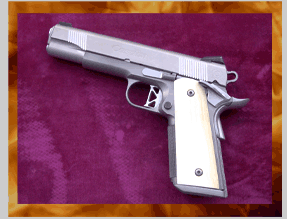|
Nickel, Silver and Gold Plating
For the longest time fun collectors and shooters alike have searched for a beautiful, durable, non-rusting finish for their metal parts. Electrolytic Nickel Plating has been one of the favorite plated finishes, and meets all of these requirements. In addition, Electrolytic Nickel Plating will deposit an absolutely uniform plate thickness over the entire piece, smooth and diamond bright. Satin nickel finishes are also available.
Electrolytic Plating or electroplating is best explained in as simple a manner as possible. A part to be nickel plated is first stripped of all coating and oxide's (ext. sanded and polished down to bare smooth metal and then made absolutely chemically clean). This bare and clean part is then connected to the negative terminal on the rectifier and submerged in a tank of electroking solution. Next, the part is transferred to the activator solution. At this time, the part is ready to be plated. The part (which is now called a cathode is suspended into a liquid solution known as electrolyte is a bar of pure nickel hung from a copper wire that is attached to the positive side of the rectifier which will act as an anode. The electrical current then flows from the rectifier through the bar of nickel (the anode), causing some of the nickel from the bar to be electro chemically moved into the electrolyte. Since the electrolyte is already super-saturated with nickel, it can absorb no more of that metal unless it first gives up some of the nickel that is already in the solution. This transfer occurs in the electrolyte as the current flows through the port (the cathode) on towards the negative ground of the rectifier. As the electrical current slows from positive to negative, the electrolyte gives up some of its nickel and deposits it uniformly over the entire surface of the part being plated, the cathode.
Now that the process is understood, let's look at the different results of Electrolytic Plating. Our most common plated finishes are high-polish nickel, satin nickel, brushed nickel and antique nickel. The variance between finishes is obtained through the metal preparation. High polish nickel is obtained by block sanding and polishing to a mirror-like shine, then plated. Satin nickel is done by light media blasting of glass bead leaving the surface rough and then plated. Brushed nickel is sanded, polished to a high luster, brush strokes or scratches are applied using a carding wheel and then plated. Antique nickel is similar to satin nickel, but does not have the rough appearance. The metal is sanded and polished to a high shine, aged through a chemical process giving the metal a "fuzzy" look, cleaned extremely well and then plated. The resulting gun has a very aged, dull, bare metal look with the rust and corroding resistance of a nickel plated gun.
Nickel plating has long been a favorite finish for many handguns, but can also be used on rifles and shotguns. A shotgun with a nickel receiver and blued barrel is quite attractive and an AR-15 with nickel accents provides a decorative effect, protection against rust and corrosion and a wear-resisting surface. The possibilities are endless.
Silver and Gold Finishes
Silver and gold plating are also available. Nickel is first applied to the gun using the regular process described above. The silver and gold are then plated over the top of the Nickel. Since Nickel adheres better to steel then either silver and gold, this method provides a more durable and flake-resistant surface. The silver and gold's final luster follows that of the nickel, as discussed in the metal preparation process above. While nickel creates a chrome-like finish, silver yields a color more similar to white gold.
|

|









